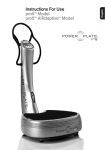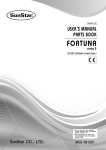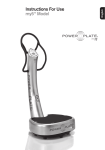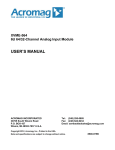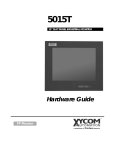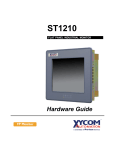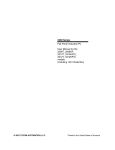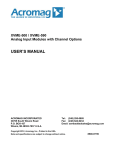Download USER`S MANUAL
Transcript
XVME-212 6U 32-Channel Digital Input Module USER’S MANUAL ACROMAG INCORPORATED 30765 South Wixom Road P.O. BOX 437 Wixom, MI 48393-7037 U.S.A. Tel: (248) 295-0885 Fax: (248) 624-9234 Email: [email protected] Copyright 2012, Acromag, Inc., Printed in the USA. Data and specifications are subject to change without notice. 8500-967B XVME-212 Manual August, 1989 Chapter 1 INTRODUCTION 1.1 INTRODUCTION The XVME-212 is a 32 channel, opto-isolated, digital input interface, designed to be compatible with the VMEbus structure. The XVME-212 is capable of receiving 32 digital inputs at frequencies up to 3.4 KHz. To ensure signal integrity, the design incorporates integrated “switch” debouncing, as well as the protection provided by the optical isolation of the channel inputs from the system bus structure. In addition, an on-board scanner can be programmed to generate a VMEbus interrupt when any input changes state, thus eliminating the need to poll the input module. Each digital input is reverse voltage protected and is capable of handling a maximum reverse bias of 50V DC (XVME-212/l) or 6.5V DC (XVME-212/2). Also, the board can be jumpered to occupy any 1K block within the short I/O address space. The following two versions of the XVME-212 are available: XVME-212/l -- The /l version of the XVME-212 comes with an on-board, 12V DC, isolated power supply. The 12V supply is factory-connected to the input of each channel, thus permitting the system to monitor 12V relay contacts and switches without an external power supply. Voltages other than the 12V may be applied to the inputs (within the l0V50V input range); however, some board modification will be necessary (i.e., cutting the well identified and easily accessible PC traces to the 12V on-board supply). XVME-212/2 -- The /2 version of the XVME-212 is very similar to the /I version except for the range of allowable input voltage and the absence of an on-board +12V DC power supply. The XVME-212/2 has TTL level inputs with a 6.5V maximum input. In addition, the +12V isolated, on-board power supply is not available, replaced by wire jumpers to the existing +5V supply of the VME backplane. 1.2 MANUAL STRUCTURE This first chapter provides a functional overview of the XVME-212 and presents the features of Xycom’s Standard I/O architecture. Operational aspects of the XVME-212 are then explained in the following fashion: Chapter 2 - Installation: Information required to position the jumpers and switches on the XVME-212, and install the module in a VMEbus chassis. Chapter 3 - Programming: Information required to program the XVME-212 and read digital input signals. The appendices at the end of this manual provide information on Xycom’s Standard I/O Architecture, VMEbus connector/pin descriptions, module schematics, as well as a quick reference guide to the module’s jumpers and registers. 1-l XVME-2 12 Manual August, 1989 - Module identification - The XVME-212 has ID information which provides its name, model number, manufacturer, and revision level at a location that is consistent with other Xycom I/O modules. - Status/Control Register - This register is always located at address base + 8 lH, and the lower four bits (two Test Status bits, and a red and green LED bit) are standard from module to module. A detailed description of Xycom I/O Architecture is presented in Appendix A at the rear of this manual. 1.5 XVME-212 MODULE SPECIFICATIONS Table l-l. XVME-2 12 Module Specifications / Characteristic / ’ Number of Channels Specification ~ Input Voltage Range (XVME-212/l) I I +5OV DC max. Logic 1 -- 10 to 5OV DC Logic 0 -- 0 to lV DC Typical t h r e s h o l d- - 3 V DC : Input Voltage Range (XVME-212/2) +65V DC max. Logic 1 -- 2 to 6.5V DC Logic 0 -- 0 to 0.8V DC Typical threshold -- 1.2V DC 1 Input Impedance (XVME-2 12/ 1) : Input Impedance (XVME-2 12/2) 3.9K +5% 330 +5% ~ Propagation Delay ~ (with fastest debounce selected) Of f-to-on On-to-off 100 usec max. (l0-25 usec typ.) 600 usec max. (150 usec typ.) ~ Minimum Detectable Pulse Width Positive pulse II Negative pulse I 100 usec max. (l0-25 usec typ.) 600 usec max. (150 usec typ.) ~ Maximum Input Frequency 3.4 KHz typical 32 Debounce Time Jumper-selectable from 4.5 usec to 18 msec (8 possible settings) Reverse Bias Protection (XVME-212/l) - 50 V max. Reverse Bias Protection (XVME-2 12/2) - 6.5V max. Power Requirements +5V, 25% 1.7 Amp typ., 2.0 Amp max. 1-3 XVME-2 12 Manual August, 1989 Table l-l. XVME-2 12 Module Specifications (cont’d) Characteristic Specification Isolation 300 VDC channel-to-channel 300 VDC channel to VMEbus ground Board Dimensions NEXP board size (160mm x 233.4mm) Environmental Specifications Temperature Operating 0’ to 65’C (32’ to 149’F) -40’ to 85’C (-40’ to 158’F) Non-operating Humidity 5 to 95% RH, non-condensing (Extremely low humidity conditions may require special protection against static discharge.) Altitude Operating Sea level to 20,000 ft. (6096m) Sea level to 50,000 ft. (15240m) Non-operating Vibration Operating Shock I 5 to 2000 Hz .O 15” peak-to-peak displacement 2.5g peak acceleration Non-operating 5 to 2000 Hz .030” peak-to peak displacement 5.0 g peak (maximum) acceleration Operating 30 g peak acceleration, 11 msec duration Non-operating 50 g peak acceleration, 11 msec duration 1-4 XVME-2 12 Manual August, 1989 Table l- 1. XVME-2 12 Module Specifications (cont’d) -~~ ~~~-~ Characteristic Specification VMEbus Compliance l l l l l l l 1-5 Fully compatible with VMEbus standard Al 6:D16 Data transfer bus slave Base address jumper-selectable within 64K short I/O address space Occupies 1K consecutive byte locations I(1) to I(7) Interrupter (STAT) with programmable vector Includes Xycom’s standard I/O module interface NEXP XVME-212 Manual August, 1989 Chapter 2 INSTALLATION 2.1 INTRODUCTION This chapter provides the information needed to configure the XVME-212 and to install it in a VMEbus backplane card cage. 2.2 SYSTEM REQUIREMENTS The XVME-212 is a double-high VMEbus compatible module. To operate, it must be properly installed in a VMEbus backplane cardcage. The minimum system requirements for operation of the XVME-212 are one of the following (either A or B below): A) A host processor properly installed on the same backplane. A properly installed controller subsystem. An example of such a control subsystem is the Xycom XVME-010 System Resource Module. -OR- B) A host processor which incorporates an on-board controller subsystem. 2.3 LOCATION OF COMPONENTS RELEVANT TO INSTALLATION The \ jumpers, switches, and connectors on the XVME-212 are illustrated in Figure 2-1. 2-1 XVME-212 Manual August, 1989 2.4 JUMPERS/SWITCHES Prior to installing the XVME-212, it is necessary to choose several jumper/switch selectable options. These options fall into two categories: VMEbus-related options and debounce period jumpers. VMEbus Options Module base address, selected by switches l-6 of the Address Switches (Sl) Privilege level required to access the module, selected by Switch 7 of the Address Switches (Sl) VMEbus interrupt level, selected by the Interrupt Level Switches (S2) Whether to use or bypass the IACK daisy chain, selected by Jumpers Jl and J2 Debounce Period Jumpers The length of the debounce period is selected by Jumpers J4 and Jl1. - 2-3 XVME-212 Manual August, 1989 Table 2-1. XVME-212 Jumper/Switch List Jumper/Switch Use Address Switches (Sl) S1 (switches 1-6) Module Base Address Select Sl (switch 7) This switch determines whether the module will respond only to supervisory accesses or to both supervisory and non-privileged accesses. Sl (switch 8) This switch works in conjunction with Jumper J3 to determine whether the board operates with address modifiers for Short I/O Address Space or those for Standard Address space. (See note below.) Interrupt Level Switches (S2) Selects the interrupts to be generated by a change of state on input lines. Jl, J2 Selects whether to use or bypass the IACK daisy chain. J3 This jumper works in conjunction with Sl (Switch 8) for address space selection (i.e., Short I/O Address Space or Standard Address Space. (See note below.) J4 - Jll Determines the debounce period. Note See also Section 2.4.2, Switch 8 of Switch Bank Sl. 2.4.1 Base Address Selection Switches (Sl-1 to Sl-6) The XVME-212 module is designed to be addressed within either the VMEbus Short I/O or Standard Memory Space. Since each I/O module connected to the bus must have its own unique base address, the base addressing scheme for the XVME I/O modules has been designed to be switch or jumper selectable. When the XVME-212 module is installed in the system, it will occupy a 1 Kbyte block of the Short I/O Memory or Standard Address Space (called the module I/O Interface Block). 2-4 XVME-212 Manual August, 1989 2.4.2 Address Space Selection (J3) The XVME-212 may be placed in VMEbus Short I/O or Standard Memory Space. The selection is made by configuring Jumper J3 and Switch 8 of Switch Bank Sl (see Figure 2-2) as shown in Table 2-3 below. Table 2-3. Addressing Options (J3) Jumper Switch 8 (Sl) Option Selected J3A J3B Open Closed Standard Data Access Operation Short I/O Access Operation . If Jumper J3A is installed, Switch 8 (on Switch bank Sl) must be set to OPEN. If Jumper J3B is installed, Switch 8 must be set to CLOSED. The Standard I/O Architecture recommends that the XVME-212 operate within the Short I/O Address Space, in order to take advantage of the Standard I/O Architecture’s various features, which are described in Appendix A. If required, the XVME-212 can operate in the Standard Address Space. Note that in this mode, the XVME-212 will always reside within the upper 64 Kbyte segment of the Standard Memory Address Space (i.e., the address range FF0000H through FFFFFFH). Sl switches 1 through 6, then determines which 1K block of the upper 64 Kbyte segment is to be occupied. 2.4.3 Supervisory/Non-Privileged Mode Selection The XVME-212 can be configured to respond only to supervisory access, or to both nonprivileged and supervisory accesses, by selecting the position of Switch 7 (located in Switch Bank Sl, see Figure 2-2), as shown in Table 2-4 below. I 2.4.4 Table 2-4. Privilege Options Switch 7 Privilege Mode Selected Closed Open Supervisory or Non-privileged Supervisory Only Address Modifier Reference Table 2-5 below indicates the actual VMEbus Address Modifier code that the XVME-212 will respond to, based on the position of the options discussed in the previous two sections. 2-7 XVME-212 Manual August, 1989 Table 2-5. Address Modifier Code Options T Switches 8 7 Jumper J3 XVME-212 Address Modifier Code Normal Short I/O Closed Open Closed Closed B B 29H or 2DH 2DH only Standard Address Closed Open Open Open A A 39H or 3DH 3DH only 2.45 Interrupt Level Switches (S2) The three Interrupt Level Switches select which VMEbus interrupt level is to be used by the module. The XVME-212 can be programmed to generate an interrupt whenever a change of state is detected on any input line, and these switches will determine the level of that interrupt. The Interrupt Level Switches are defined in Table 2-6. Table 2-6. Interrupt Level Switches (S2) S2-3 S2-2 OPEN OPEN OPEN OPEN CLOSED CLOSED CLOSED OPEN OPEN CLOSED CLOSED OPEN OPEN CLOSED 2.4.6 S2-1 VMEbus Interrupt Level OPEN CLOSED OPEN CLOSED OPEN CLOSED OPEN 7 6 5 4 3 2 1 None, interrupts disabled IACK Enable Jumpers (Jl, J2) When operating in an interrupt environment, the module uses the VMEbus IACK daisy chain to determine which module gets acknowledged, if two or more modules share one of the interrupt request lines. When the module is never going to be used in an interrupt environment, the daisy chain through the module can be bypassed to speed up the IACK arbitration. This is controlled by Jumpers Jl and J2, as shown in Table 2-7. Table 2-7. IACK Enable Jumpers A 9. Module uses IACK daisy chain Module bypasses IACK daisy chain 8 2-8 Jl J2 B A B A XVME-212 Manual August, 1989 When in the A position, the module cannot respond to interrupts because IACKIN* is not monitored (IACKIN* is connected directly to IACKOUT* instead). When used in this configuration, all poles of S2 should be closed to ensure that a programming bug does not generate VMEbus interrupts. When interrupts are going to be used, the jumpers must be in the B position. 2.4.7 Debounce Period Jumpers (J4-J 11) When a mechanical switch closes, several contact bounces can be expected. Several transitions or quickly changing input images can appear while the switch bounces. To eliminate these bounces, circuitry is provided, which works as follows. When a change is detected in an input, the change is not immediately reported to the scanner. Instead, a timer, with time period, T, will start accumulating time. During this time, T, if the input reverts to its original state (bounces), the timer is restarted and the change is not reported. If the input does not bounce for the duration of time, T, the change will be reported to the scanner at the end of time period T. This means that the input must assume the new state and stay in the new state without bouncing for time, T, before the change is reported to the scanner. The value of time, T, is selectable via eight on-board jumpers. One and onlv one jumper must be installed. This jumper defines the time, T, to be used by all 32 channels. The following table shows the available selections. Table 2-8. Debounce Period Jumpers install only one Jumper T min T max Jll Jl0 J9 J8 J7 J5 J4 J6 3.5 us 7 us 14 us 28 us 112 us 448 us 1.8 ms 14 ms 4.5 us 9 us 18 us 36 us 144 us 576 us 2.3 ms 18 ms Note One (and only one) of the above jumpers must be installed for proper module operation. Note that the time associated with Jll is very short with respect to the opto isolator’s response time. So selecting this time will essentially defeat the debounce circuitry for users concerned about speed and not concerned about bounce. 2.5 INSTALLATION The Xycom VMEbus modules are installed in a standard VMEbus backplane. Figure 2-3 2-9 XVME-212 Manual August, 1989 Installation 2.5.1 Procedure CAUTION Never attempt to install or remove any boards before turning off the power to the bus, and all related external power supplies. Prior to installing a module, determine and verify all relevant jumper configurations, and all connections to external devices or power supplies. (Please check the jumper configuration against the diagrams and lists in this manual.) To install a board in the card cage, perform the following steps: 1) Make sure the cardcage slot (which will hold the module) is clear and accessible. 2) Center the board on the plastic guides in the slot so that the solder side is facing to the left and the component side is facing to the right (refer to Figure 2-3). 3) Push the board slowly toward the rear of the chassis, until the connector engage (the board should slide freely in the plastic guides). 4) Apply straightforward pressure to the handle on the panel front, until the connector is fully engaged and properly seated. NOTE It should not be necessary to use excessive force or pressure to engage the connectors. If the board does not properly connect with the backplane, remove the module and inspect all connectors and guide slots for possible damage or obstructions. 5) 2.6 Once the board is properly seated, secure it to the chassis by tightening the two machine screws at the extreme top and bottom of the board. DIGITAL INPUT CONNECTIONS The module is capable of receiving 32 separate digital inputs. The inputs are accessible on the front edge of the board in the form of two 50-pin ribbon headers. The connectors are labeled JKl and JK2 (see Figure 2-l). The following table shows the pin designations for connectors JKl and JK2. 2-11 XVME-212 Manual August, 1989 Table 2-9. Input Connector Signal Definitions Connector Pin Number 1 2 3 4 5 6 7 8 9 10 11 12 13 14 15 16 17 18 19 20 21 22 23 24 25 26 27 28 29 30 31 32 33 34 35 36 37 38 39 40 41 42 43 44 45 46 47 48 49 50 JK2 Connection JK 1 Connection ’ CHOCHO+ CHlCHl+ CH16CH16+ CH17CH17+ CH2CH2+ CH3CH3+ CH18CH18+ CH19CH19+ CH4CH4+ CH5CH5+ CH20CH20+ CH21CH21+ CH6CH6+ CH7CH7+ CH22CH22+ CH23CH23+ CH8CH8+ CH9CH9+ CH24CH24+ CH25CH25+ CHl0CHlO+ CHIlCHll+ CH26CH26+ CH27CH27+ CH12CH12+ CH13CH13+ CH28CH28+ CH29CH29+ CH14CH14+ CH15CH15+ CH30CH30+ CH31CH31+ / 12V Return (XVME-212/l) Ground (XVME-2 12/2) 12V Return (XVME-212/l) Ground (XVME-2 12/2) 2-12 12V Return (XVME-212/l) Ground (XVME-2 12/2) 12VReturn(XVME-212/l) Ground (XVME-2 12/2) XVME-212 Manual August, 1989 2.7 MECHANICAL SWITCH/RELAY OPERATION 2.7.1 XVME-212/l With the XVME-212/l, an isolated 12V DC supply is available for use with mechanical switches. The 12V supply’s positive terminal is connected to the “+” terminal of each input channel. The 12V supply’s return terminal is connected to pins 49 and 50 of the JK connectors (see Table 2-9). The external switch should be connected between the “-” terminal of the particular input channel and pins 49, 50. When the switch closes, the 12V return is connected to the "-" terminal of the input channel which turns the input channel on. No external supplies are required. Note that all input channels have their “+" terminals connected together (they are all connected to the 12V supply). Some users will want electrical isolation between channels. To facilitate this, break points are available for all 32 input channels. When the breakpoint is cut, the input channel’s “+" terminal is disconnected from the isolated supply and the other input channels. The 12V supply cannot be used on a channel when its break point is cut, however. These break points are labeled as CHO - CH31 on the board and are easily accessible from the circuit side of the board under the 32 1 W resistors. Pads are provided on either side of the break point to allow reconnection, if required. The 300V channel-to-channel isolation specification applies onlv to channels which have their break point cut. The 300V channel to VMEbus isolation is maintained whether the break points are cut or not (because the 12V supply is isolated to 300V). 2.7.2 XVME-212/2 With the XVME-212/2, the +5V supply of the VME backplane is used with the mechanical switches. Each “+" terminal of the input channels is connected to +5V (with reference to logic ground) while pins 49 and 50 of the JK ports are connected to logic ground. (See Table 2-9.) The external switch should be connected between the “-” terminal of the particular input channel and pins 49, 50. When the switch closes, logic ground is connected to the “-" terminal of the input channel, which then turns on the input channel. Note that all input channels have their “+” terminals connected together; they are all connected to +5V. Some users will want electrical isolation between channels. To facilitate this, break points are available for all 32 input channels. When the breakpoint is cut, the input channel’s “+" terminal is disconnected from the +5V supply and the other input channels. The +5V cannot be used on a channel once its break point is cut, however. These break points are labeled CHO - CH31 on the board and are easily accessible from the circuit side of the board. Pads are provided on either side of the break point to allow reconnection, if required. The 300V channel-to-channel and the 300V channel-to-VMEbus isolation applies ONLY to channels which have their break point cut. 2-13 XVME-212 Manual August, 1989 Chapter 3 PROGRAMMING 3.1 INTRODUCTION This chapter provides the information required to program the XVME-212, including the following: Discussion of base addressing and I/O module address space l Presentation of module address map showing programming locations 3.2 BASE ADDRESSING The XVME-212 operates as an I/O module in VMEbus systems and is located in the 64K VMEbus Short I/O Address Space (or the upper 64K of the Standard Address space). It can be located at any one of 64 base addresses at 1K intervals within this address space. The base address is selected via the switches described in Section 2.4.1. When located at its base address, the XVME-212 is allotted a 1K block of address space for its own use. This 1K block of address space is termed the I/O Interface Block, and contains all of the module’s programming locations. Figure 3-l shows the I/O Interface Block of the XVME-212 and its relation to the address space. When accessing locations in the I/O Interface Block, the addresses shown in Figure 3-1 must be added to the module’s base address. For example, if the XVME-212 is located at Short I/O Base Address 0400H, of the Control/Status register is 0481H (base+8lH). 3-1 the address XVME-212 Manual August, 1989 3.3 I/O INTERFACE BLOCK The I/O Interface.Block of the XVME-212 contains the following programming locations (as shown in Figure 3-1) which are defined in greater detail later in the chapter. - I.D. information (base+OlH to base+3FH): These locations provide information specifying model number, manufacturer, and revision level. Extended Status Register (base+80H) and Status/Control Register (base+8 1H): These locations enable/disable interrupts from each of the four ports, indicate if an interrupt is pending, and control the Pass and Fail LEDs. - Interrupt Acknowledge (IACK) Vector Register (base+83H), which holds the vector to be driven on the VMEbus when a VMEbus interrupt generated by the XVME-2 12 is acknowledged. - Data Registers which hold the data from the four ports. Change registers which indicate whether data on any channel has changed. Note Reading or writing to undefined locations may make application software incompatible with future versions of this module. 3.4 MODULE IDENTIFICATION DATA (Base+0lH to 3FH - odd byte locations only) The Xycom module identification scheme provides a unique method of registering module-specific information in an ASCII encoded format. The I.D. data is provided as 32 ASCII encoded characters consisting of the board type, manufacturer identification, module model number, number of 1K byte blocks occupied by the module, and module functional revision level information. This information can be read by the system processor on power-up to verify the system configuration and operational status. Table 3-1 defines the identification information locations. 3-3 XVME-2 12 Manual August, 1989 Extended Status and Status/Control Register Bit Definitions 3.5.1 0 1. A Red LED.. Green LED These bits control the red and green LEDs. The red and green LEDs provide visual indication of a module status. - A logic “0” turns on the red LED (D0) A logic “1” turns on the green LED (Dl) The LEDs should be used to indicate the following status (Table 3-2) as set forth by the Xycom architecture (described in Appendix A). Table 3-2. LED Status , Status Bits 1 0 4 LEDs Green 1 Red SYSFAIL* Status Module failed, or not yet tested Inactive module Module undergoing test Module passed test 0 0 OFF ON ON 0 1 1 1 0 1 OFF ON ON OFF ON OFF OFF ON OFF Note The XVME-212 is a non-intelligent module, so all diagnostics must be performed by the system host. 2 VMEbus Interrupt Pendinq This read-only bit reads 1 whenever BOTH of the following conditions are met: One or more of the Change Register n Interrupt Enable bits (bits 4-7 of the Status/Control Register) has been set to 1. AND A bit in one of the interrupt-enabled Change Registers associated with a port has the value 1. A bit value of 1 in a Change Register indicates that a change of state has occurred on a specified input channel. VMEbus Interrupt Enable This bit enables VMEbus interrupts from the XVME-212 module: 12- a VMEbus interrupt will be generated automatically whenever the XVME-212 sets bit 2 to 1. no VMEbus interrupt will be generated. 3-6 XVME-212 Manual August, 1989 4-7 . d Change Register n Interrupt Enable These bits individually enable the Change Registers to generate VMEbus interrupts whenever any bit in a Change Register is set. Writing a 1 in one of these bits enables interrupts from a specific Change Register, writing 0 disables interrupts from the register. Bit 4 -- Enables/disables Change Register 0 Bit 5 -- Enables/disables Change Register 1 Bit 6 -- Enables/disables Change Register 2 Bit 7 -- Enables/disables Change Register 3 3-7 XVME-2 12 Manual August, 1989 8-l1: Change Register n Status Change Register Status bits: Bit Bit Bit Bit 8 -- Status of Change Register 0 9 -- Status of Change Register 1 10 -- Status of Change Register 2 11 -- Status of Change Register 3 When the scanner detects a bit set in a Change Register, it will set the appropriate above bit to 1. These bits are reset to zero when the corresponding Data Register is read. These bits may be polled to quickly determine whether any Change Registers have bits set. These bits are not conditioned by any one of the interrupt enable bits 4-7. 12-15: Not used. 3.5.2 Generating VMEbus Interrupts Bits 4-7 of the Status/Control Register are individually ANDed with bits 8-11. The results of the ANDs are ORed together to produce bit 2. Bit 2 is ANDed with bit 3 and when the result of this AND is 1, a VMEbus interrupt will be generated. The level of the VMEbus interrupt is determined by the setting of Switch bank S2 (see Section 2.4.5). Section 3.8 describes in detail how interrupts are generated. 3.6 INTERRUPT ACKNOWLEDGE (IACK) VECTOR REGISTER (base+83H) This write-only register holds the vector to be driven on the VMEbus when a VMEbus interrupt generated by the XVME-212 is acknowledged. 3.7 DATA REGISTERS Four read-only Data Registers hold the state of the XVME-212’s four input ports (see Figure 3-3). 3-8 XVME-212 Manual August, 1989 Register is read. This ensures that the data read from the Change and Data Registers is from the same scan (when a Change Register read is followed by a Data Register read). If the scanner were allowed to run, a Change Register bit could be set after the Change register was read but before the Data Register is read. Because reading a Data Register zeros the Change Register, any Change Register bits set between the two reads would be lost. Stopping the scanner in this fashion ensures that no change Register bits will be lost. 3.9.3 Restarting the Scanner If the scanner is stopped due to reading the Change Register, it can be restarted by reading the Data Register, the Extended Status, or the Status/Control Register. The scanner is also started up automatically after the XVME-212 is reset. 3.10 VMEbus INTERRUPTS Each of the four Change Registers has an interrupt enable bit in the Status/Control Register (bits 4-7). When this bit is set, a VMEbus interrupt will be generated when any bit of the corresponding Change Register is set and the VMEbus Interrupt Enable bit (bit 3 of the Status/Control Register) is set. This alerts the CPU that an input has changed state since the last time the CPU read the data registers. Figure 3-5 illustrates the logic involved in generating a VMEbus interrupt. Reading the corresponding Data Register will reset the VMEbus interrupt (because reading the Data Registers will reset the corresponding Status/Control bit 8-11). When the VMEbus interrupt enable (bit 3) is reset no VMEbus interrupt will be generated. By using the interrupt mechanism, the VMEbus is relieved of the traffic required to constantly poll the module. The level of the VMEbus interrupt generated by the XVME-212 is determined by the setting of Switch bank S2 (see Section 2.4.5). The IACK vector is determined by the contents of the IACK Vector Register at location base+83H (see Section 3.6). 3-11 XVME-212 Manual August, 1989 3.11 PROGRAMMING CONSIDERATIONS Use the following procedure to ensure that no change bits in a Change Register are zeroed before they are read. The Change Register must be read first, which will stop the scanner. Then the Data Register is read, which will zero the Change Register and restart the scanner. The reason for this sequence is explained in Section 3.9.2. Reading any Change Register stops the scanner and reading any Data Register restarts it. The usershould therefore read the Data registers as logical pairs (i.e., read Change Register 3, then Data Register 3, not Change Register 3 then Data Register 2). These logical pairs may be words or bytes. For example, to read all channels on the board as words, the correct sequence is: 1. 2. 3. 4. read read read read Change Registers 0 and I (as one word) Data Registers 0 and 1 (as one word) Change Registers 2 and 3 (as one word) Data Registers 2 and 3 (as one word) During the time that the scanner is stopped, no changes in state will be detected and the Data Registers are not updated. In systems which must keep up with the fast changing inputs, the time that the scanner is stopped must be minimized. It is therefore necessary to read the Extended Status, Status/Control, or Data Registers (restarting the scanner) quickly after the Change Register is read (stopping the scanner). It is suggested that the user disable all CPU interrupts between the two reads. If an interrupt is taken after the Change Register read but before the data/status registers are read, the scanner would be off for the duration of the interrupt service routine. The following chart shows the relationship of input channel signals with respect to stopping the scanner. 3-13 XVME-212 Manual August, 1989 3 . 4. The data read at point B was the data present at the start of scan n+l, because the data registers are not updated while the scanner is stopped. The data read at point B caused Change Register bit y to clear. Polled operation is enhanced by bits 8-11 of the Extended Status Register. These bits are set when the scanner detects any change bit set in a Change Register. These bits can be polled to quickly determine whether any of the input channels have changed state since the CPU last read the Data Registers. If bits 8-11 are zero, then no input channels have changed since the CPU last read the Data Registers and there is no need to read the Data Registers again. Polling the Extended Status Register instead of the Change Registers has two advantages. First, because the scanner is not stopped, it doesn’t have to be restarted after the read. Secondly, Status Register reads are faster because the scanner does not have to be stopped before DTACK is asserted. It is therefore suggested that bits 8-11 of the Extended Status be polled instead of polling the Data or Change Registers directly. It is not necessary to read the Change Registers at all if the user is not concerned which individual bit in the change register is set. In these cases, the user would read the Data Registers when the module generated an interrupt (in interrupt environments) or when the status bits 8-11 indicate a change has occurred (in environments). about simply driven polled 3.12 RESETTING THE MODULE The module is reset by the assertion of the VMEbus reset signal. In response to-a reset, the module will do the following. All bits of the Extended Status and Control/Status Registers will be reset to zero. (Note that this resets all Interrupt Enable bits of the Status/Control Register so the VMEbus interrupt currently being generated by the XVME-212 will be negated, and the SYSFAIL* will be asserted on the VMEbus because bit 0 is reset to zero.) The scanner is stopped and the Data and Change Registers are reset to zero. After the reset signal is negated, the scanner will start scanning. Before the first scan, all Data and Change Registers will be zero. Therefore, after a reset, when an input channel is detected as on, its corresponding Change Register bit will be set. 3-15 XVME-212 Manual August, 1989 Appendix A XYCOM STANDARD I/O ARCHITECTURE INTRODUCTION The purpose of this appendix is to define XYCOM’s Standard I/O Architecture for XVME I/O modules. This Standard I/O Architecture has been incorporated on all programming for the entire module line. The I/O Architecture specifies the logical aspects of bus interfaces, as opposed to the “physical” or electrical aspects as defined in the VMEbus specifications. The module elements which are standardized by the XYCOM I/O Architecture are the following: 1. Where a module is positioned in the I/O address Module Addressing: space and how software can read from it or write to it 2. Module Identification: installed in a system 3. Module Operational Status: How the operator can (through software) determine the operational condition of specific modules within the system 4. Interrupt Control: How software is able to control and monitor the capability of the module to interrupt the system 5. Communication between Modules: How master (host) processors and intelligent I/O modules communicate through shared global memory or the dual-access RAM on the modules 6. The I/O Kernel: How intelligent and non-intelligent “kernels” facilitate the operation of all XYCOM I/O modules How software can identify which modules are MODULE ADDRESSING The XYCOM I/O Architecture Design Specification recommends that XVME modules should be addressed within the VMEbus-defined 64K short I/O address space. The restriction of I/O modules to the short I/O address space provides separation of program/data address space and the I/O address space. This convention simplifies software design and minimizes hardware and module cost, while providing 64K of address space for I/O modules. A-l XVME-212 Manual August, 1989 Standardized Module I/O Map The block of short I/O addresses (called the I/O Interface Block) allocated to each XVME module is mapped with a standardized format in order to simplify-programming and data access. The locations of frequently used registers and module-specific identification information are uniform. For example, the module identification information is always found in the first 32 odd bytes of the module memory block. These addresses are associated with the jumpered base address (i.e., Module I.D. data address = base + odd bytes IH - 3H). The byte located at base address + 81H on each module contains a Status/Control register which provides the results of diagnostics for verification of the module’s operational condition. The next area of the module I/O Interface Block (base address + 82H, up to FFFH) is module-specific, varying in size from one module to the next. It is in this area that the module holds specific I/O status, data, and pointer registers for use with IPC protocol. All intelligent XVME I/O modules have an area of their I/O Interface Blocks defined as “dual access RAM.” This area of memory provides the space where XVME “slave” I/O modules access their command blocks and where XVME “master” modules could access their command blocks (i.e., “master” modules can also access global system memory). The remainder of the I/O Interface Block is then allocated to various module-specific tasks, registers, buffers, ports, etc. Figure A-2 shows an address map of an XVME I/O module interface block, and how it relates to the VMEbus short I/O address space. This example shows an I/O Interface Block that occupies a 1K segment of short I/O Address Space. It should be noted that some modules (the XVME-164 MBMM for example) will occupy up to a 4K segment of short I/O Address Space. Notice that any location in the I/O Interface Block may be accessed by simply using the address formula: Module Base Address + Relative Offset = Desired Location A-3 XVME-212 Manual August, 1989 The module status/control register (found at module base address + 8lH) on intelligent XVME I/O modules provides the current status of the module self-test in conjunction with the current status of the front panel LEDs. The status register on intelligent modules is a “Read Only” register and it can be read by software to determine if the board is operating properly. On non-intelligent XVME I/O modules, the status/control register is used to indicate the state of the front panel LEDs, and to set and verify module-generated interrupts. The LED status bits are “Read/Write” locations which provide the user with the indicators to accommodate diagnostic software. The Interrupt Enable bit is also a Read/Write location which must be written to in order to enable module-generated interrupts. The Interrupt Pending bit is a “Read Only” bit indicating a module-generated pending interrupt. A-7 XVME-2 12 Manual August, 1989 INTERRUPT CONTROL Interrupts for non-intelligent modules can be enabled or disabled by setting/clearing the Interrupt Enable bit in the module status register. The status of pending on-board interrupts can also be read from this register. Interrupt control for intelligent modules is handled by the Interprocessor Communications Protocol. Communications Between Processors Communications between an intelligent ‘master’ and an intelligent ‘slave” I/O module is governed by XYCOM’s Interprocessor Communication (IPC) Protocol. This protocol involves use of 20-byte Command Block data structures -- located anywhere in the shared global RAM or dual-access RAM on an I/O module -- to exchange commands and data between a host processor and an I/O module. THE KERNEL To standardize its XVME I/O modules, XYCOM has designed them around “kernels’ common from module to module. Each different module type consists of a standard kernel, combined with module-dependent application circuitry. Module standardization results in more efficient module design and allows the implementation of the Standard I/O Architecture. The biggest benefit of standardization for intelligent modules is that it allows the use of a common command language or protocol (Interprocessor Communication Protocol in this case). The intelligent kernel is based around either a 68000 microprocessor or a 68B09 microprocessor (on the XVME-164 MBMM). This design provides the full complement of VMEbus Requester and Interrupter options for master/slave interfacing, as well as all of the advantages provided by the various facets of the XYCOM Standard I/O Architecture (as covered earlier in this appendix). The non-intelligent kernel provides the circuitry required to receive and generate all of the signals for a VMEbus defined 16-bit ‘slave” module. The non-intelligent kernel also employs the features of the XYCOM Standard I/O Architecture (as described earlier in this Appendix). A-9 XVME-212 Manual August, 1989 Appendix B VMEbus CONNECTOR/PIN DESCRIPTION The XVME-212 Processor Module is a double-high VMEbus compatible board. There is one 96-pin bus connector on the rear edge of the board labeled Pl (refer to Chapter 2, Figure 2-I for the location). The signals carried by connector PI are the standard address, data, and control signals required for a Pl backplane interface, as defined by the VMEbus specification. Table B-l identifies and defines the signals carried by the PI connector. Table B-l. Pl - VMEbus Signal Identification Signal Mnemonic Connector and Pin Number ACFAIL* lB:3 AC FAILURE: Open-collector driven signal which indicates that the AC input to the power supply is no longer being provided, or that the required input voltage levels are not being met. IACKIN* IA:21 INTERRUPT ACKNOWLEDGE IN: Totem-pole driven signal. IACKIN and IACKOUT signals form a daisychained acknowledge. The IACKIN signal indicates to the VME board that an acknowledge cycle is in progress. IACKOUT* 1A:22 INTERRUPT ACKNOWLEDGE OUT: Totem-pole driven signal. IACKIN and IACKOUT signals form a daisychained acknowledge. The IACKOUT signal indicates to the next board that an acknowledge cycle is in progress. AM0-AM5 1A:23 lB:16,17, 18,19 lC:14 ADDRESS MODIFIER (bits 0-5): Three-state driven lines that provide additional information about the address bus, such as: size, cycle type, and/or DTB master identification. AS* lA:18 ADDRESS STROBE: Three-state driven signal that indicates a valid address is on the address bus. Signal Name and Description B-l XVME-212 Manual August, 1989 Table B-l. VMEbus Signal Identification (cont’d) Signal Mnemonic Connector and Pin Number A0l-A23 1A:24-30 lC:l5-30 ADDRESS BUS (bits l-23): Three-state driven address lines that specify a memory ‘address. A24-A31 2B:4-11 ADDRESS BUS (bits 24-31): Three-state driven bus expansion address lines. BBSY* 1B:l BUS BUSY: Open-collector driven signal generated by the current DTB master to indicate that it is using the bus. BCLR* lB:2 BUS CLEAR: Totem-pole driven signal generated by the bus arbitrator to request release by the DTB master if a higher level is requesting the bus. BERR* 1C:ll BUS ERROR: Open-collector driven signal generated by a slave. It indicates that an unrecoverable error has occurred and the bus cycle must be aborted. BGOIN*BG3IN* 1 B:4,6, 8,l0 BUS GRANT (0-3) IN: Totem-pole driven signals generated by the Arbiter or Requesters. Bus Grant In and Out signals form a daisy-chained bus grant. The Bus Grant In signal indicates to this board that it may become the next bus master. BG0OUT*BG3OUT* 1 B:5,7, 9,ll BUS GRANT (0-3) OUT: Totem-pole driven signals generated by Requesters. These signals indicate that a DTB master in the daisy-chain requires access to the bus. Signal Name and Description B-2 XVME-2 12 Manual August, 1989 Table B-l. VMEbus Signal Identification (cont’d) Signal Mnemonic Connector and Pin Number BR0*-BR3* lB:12-15 BUS REQUEST (O-3): Open-collector driven signals generated by Requesters. These signals indicate that a DTB master in the daisy-chain requires access to the bus. DS0* lA:13 DATA STROBE 0: Three-state driven signal that indicates during byte and word transfers that a data transfer will occur on data buss lines (D00-D07). DSI* lA:12 DATA STROBE 1: Three-state driven signal that indicates during byte and word transfers that a data transfer will occur on data bus lines (D0-D1 5). DTACK* lA:16 DATA TRANSFER ACKNOWLEDGE: Open-collector driven signal generated by a DTB slave. The falling edge of this signal indicates that valid data is available on the data bus during a read cycle, or that data has been accepted from the data bus during a write cycle. DOO-D15 lA:l-8 lC:l-8 DATA BUS (bits 0-15): Three-state driven, b&directional data lines that provide a data path between the DTB master and slave. GND lA:9,11, 15,17,19, 1B:20,23, lC:9 2B:2,12, 22,3I GROUND Signal Name and Description B-3 XVME-212 Manual August, 1989 Table B-l. VMEbus Signal Identification (cont’d) Signal Mnemonic Connector and Pin Number IACK* 1 A:20 INTERRUPT ACKNOWLEDGE: Open-collector or threestate driven signal from any master processing an interrupt request. It is routed via the backplane to slot 1, where it is looped-back to become slot 1 IACKIN in order to start the interrupt acknowledge daisy-chain. IRQI* IRQ7*- 1B:24-30 INTERRUPT REQUEST (l-7): Open-collector driven signals, generated by an interrupter, which carry prioritized interrupt requests. Level seven is the highest priority. LWORD* lC:13 LONGWORD: Three-state driven signal indicates that the current transfer is a 32-bit transfer. (RESERVED) 2B:3 RESERVED: Signal line reserved for future VMEbus enhancements. This line must not be used. SERCLK lB:21 A reserved signal which will be used as the clock for a serial communication bus protocol which is still being finalized. SERDAT 1B:22 A reserved signal which will be used as the transmission line for serial communication bus messages. SYSCLK lA:10 SYSTEM CLOCK: A constant 16-MHz clock signal that is independent of processor speed or timing. It is used for general system timing use. Signal Name and Description B-4 XVME-2 12 Manual August, 1989 Table B-l. VMEbus Signal Identification (cont’d) Signal Mnemonic Connector and Pin Number SYSFAIL* 1C:lO SYSTEM,FAIL: Open-collector driven signal that indicates that a failure has occurred in the system. It may be generated by any module on the VMEbus. SYSRESET* lC:12 SYSTEM RESET: Open-collector driven signal which, when low, will cause the system to be reset. WRITE* lA:14 WRITE: Three-state driven signal that specifies the data transfer cycle in progress to be either read or written. A high level indicates a read operation, a low level indicates a write operation. +5V STDBY lB:31 +5 VDC STANDBY: This line supplies +5 VDC to devices requiring battery backup. +5V 1 A:32 lB:32 1C:32 2B:1,13,32 +5 VDC POWER: Used by system logic circuits. +12V 1C:31 +12 VDC POWER: Used by system logic circuits. -12v lA:31 -12 VDC POWER: Used by system logic circuits. Signal Name and Description B-5 XVME-212 Manual August, 1989 Table B-l. VMEbus Signal Identification (cont’d) Signal Mnemonic Connector and Pin Number SYSFAIL* 1C:l0 SYSTEM,FAIL: Open-collector driven signal that indicates that a failure has occurred in the system. It may be generated by any module on the VMEbus. SYSRESET* IC:12 SYSTEM RESET: Open-collector driven signal which, when low, will cause the system to be reset. WRITE* lA:14 WRITE: Three-state driven signal that specifies the data transfer cycle in progress to be either read or written. A high level indicates a read operation, a low level indicates a write operation. +5V STDBY lB:31 +5 VDC STANDBY: This line supplies +5 VDC to devices requiring battery backup. +5V 1 A:32 1 B:32 1C:32 2B:1,13,32 +5 VDC POWER: Used by system logic circuits. +12V lC:31 +I2 VDC POWER: Used by system logic circuits. -12V lA:31 -12 VDC POWER: Used by system logic circuits. Signal Name and Description B-5





































































